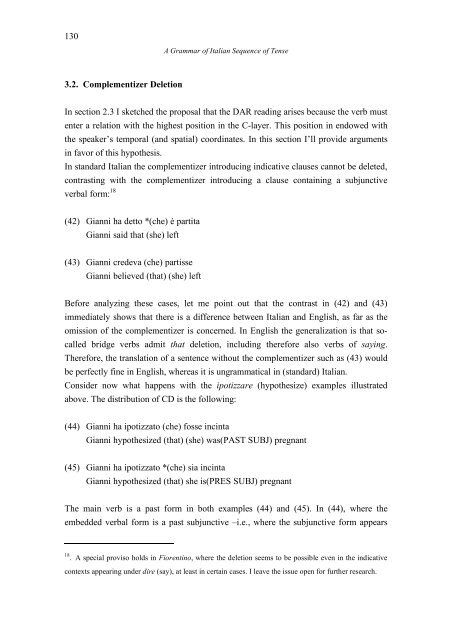A Grammar of Italian Sequence of Tense - Lear
A Grammar of Italian Sequence of Tense - Lear
A Grammar of Italian Sequence of Tense - Lear
You also want an ePaper? Increase the reach of your titles
YUMPU automatically turns print PDFs into web optimized ePapers that Google loves.
130<br />
3.2. Complementizer Deletion<br />
A <strong>Grammar</strong> <strong>of</strong> <strong>Italian</strong> <strong>Sequence</strong> <strong>of</strong> <strong>Tense</strong><br />
In section 2.3 I sketched the proposal that the DAR reading arises because the verb must<br />
enter a relation with the highest position in the C-layer. This position in endowed with<br />
the speaker’s temporal (and spatial) coordinates. In this section I’ll provide arguments<br />
in favor <strong>of</strong> this hypothesis.<br />
In standard <strong>Italian</strong> the complementizer introducing indicative clauses cannot be deleted,<br />
contrasting with the complementizer introducing a clause containing a subjunctive<br />
verbal form: 18<br />
(42) Gianni ha detto *(che) è partita<br />
Gianni said that (she) left<br />
(43) Gianni credeva (che) partisse<br />
Gianni believed (that) (she) left<br />
Before analyzing these cases, let me point out that the contrast in (42) and (43)<br />
immediately shows that there is a difference between <strong>Italian</strong> and English, as far as the<br />
omission <strong>of</strong> the complementizer is concerned. In English the generalization is that so-<br />
called bridge verbs admit that deletion, including therefore also verbs <strong>of</strong> saying.<br />
Therefore, the translation <strong>of</strong> a sentence without the complementizer such as (43) would<br />
be perfectly fine in English, whereas it is ungrammatical in (standard) <strong>Italian</strong>.<br />
Consider now what happens with the ipotizzare (hypothesize) examples illustrated<br />
above. The distribution <strong>of</strong> CD is the following:<br />
(44) Gianni ha ipotizzato (che) fosse incinta<br />
Gianni hypothesized (that) (she) was(PAST SUBJ) pregnant<br />
(45) Gianni ha ipotizzato *(che) sia incinta<br />
Gianni hypothesized (that) she is(PRES SUBJ) pregnant<br />
The main verb is a past form in both examples (44) and (45). In (44), where the<br />
embedded verbal form is a past subjunctive –i.e., where the subjunctive form appears<br />
18 . A special proviso holds in Fiorentino, where the deletion seems to be possible even in the indicative<br />
contexts appearing under dire (say), at least in certain cases. I leave the issue open for further research.
















